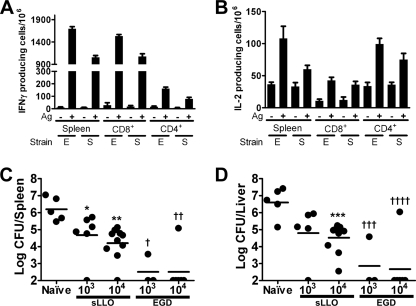FIG. 8.
T-cell responses and protective immunity following infection with the sLLO or EGD strain. (A and B) Mice were infected with 104 CFU of either the sLLO or EGD strain for 7 days. Spleen cells were isolated, and the number of IFN-γ (A)- or IL-2 (B)-producing cells was determined by ELISPOT analysis. Bars represent the mean ± standard error of the mean from three mice per group. For total spleen responses, LLOW492A mutant protein was used as the recall antigen. For CD8+ responses, the LLO(91-99) peptide was used as the recall antigen. For CD4+ responses, the LLO(188-201) peptide was used as the recall antigen. (C and D) Mice were either mock infected or were infected with the indicated doses of the sLLO or EGD strain. After 21 days, mice were rechallenged with 105 CFU of EGD. After 3 days, colony counts were determined. Bars represent the mean of two independent experiments. In panels A and B, E refers to EGD and S refers to the sLLO strain. *, P = 0.0357; **, P = 0.0007; ***, P = 0.0087; †, P = 0.0303; ††, P = 0.0007; †††, P = 0.0357; and ††††, P = 0.0013 by Mann-Whitney U test. Statistical analysis was done by comparing the immunized samples to the unimmunized control.

